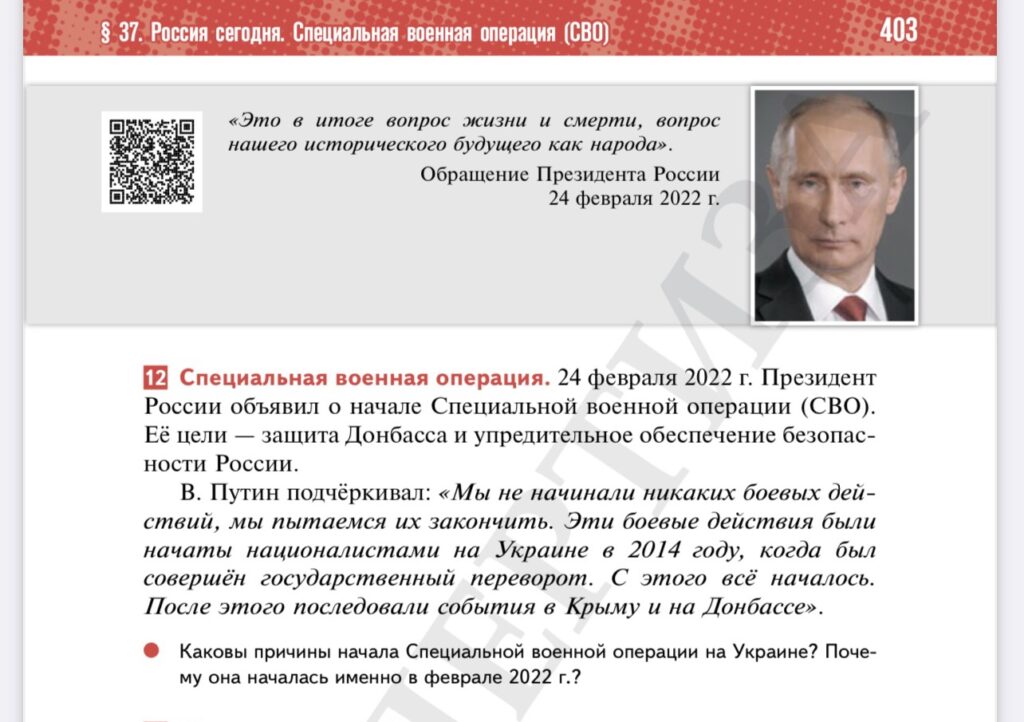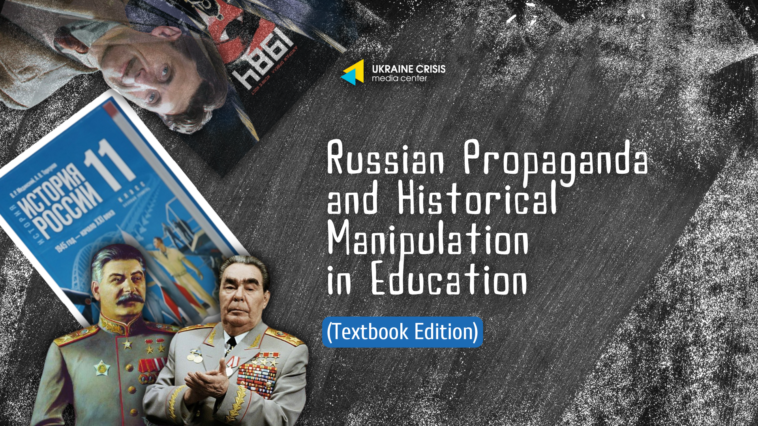Written by Matthew Wickham
“The most effective way to destroy people is to deny and obliterate their own understanding of their history.” ― George Orwell.
Russian propaganda often draws parallels with George Orwell’s ‘1984,’ reflecting the novel’s dystopian elements, such as the manipulation of media, the distortion of language to shape perceptions, and the revision of historical events to align with evolving narratives, all of which ultimately serve the interests of the ruling government. One illustration of this is the recent adaptation of Russia’s history textbook written for 11th grade students.
The re-written edition focuses on post-World War II, the emergence of the new global order, and the 21st century, encompassing the period commonly referred to as the ‘Putin era’. However, in this edition, we identified notable distortions with the intent to use this textbook not for historical education but for the indoctrination of the emerging generation and justification of the so-called ‘Special Military Operation’.
This analysis also examines the strategies utilized by the Russian state apparatus, wherein the modified curriculum is combined with the suppression of critical thinking to make the textbook more effective and thus serving the Russian state’s propaganda objectives.
Rewriting History and Curtailing Dissent in Russian Education
Vladimir Medinsky, the former Russian Minister of Culture (2012-2020), and current Chairman of Russia’s Interdepartmental Commission on Historical Education, is widely recognized for his role in manipulating history and making inflammatory statements. Notably, in 2013, he propagated the idea that Russians have an extra chromosome, revealing a penchant for baseless claims.
Understanding the widespread acceptance of the new 11th-grade edition within Russian society remains difficult due to its, so far, limited availability and delayed introduction into schools, as well as the Russian people’s fear of challenging the government’s narrative.
Medinsky’s dismissive response to criticism of the section on the post-Putin era in a recent interview exemplifies his contempt for opposing viewpoints, telling how critics wanted the section “burned”, to which he replied “That is one of the best comments an author of a textbook can receive.”
Vulnerabilities in the Russian Propaganda Apparatus
Examining textbooks from contrasting eras, 1952 under Stalin and 1980 under Brezhnev, stark differences emerge in their levels of politicization, notably diverging from the edition under discussion. This sheds light on the escalated efforts and extreme tactics current propagandists are employing to mold the minds of the younger generation.
Even during Russia’s historically tumultuous periods, when state control was at its highest, such propaganda measures to such a scale weren’t witnessed, indicating the current urgency felt by the Russian state to control the narrative.
This particular textbook strays far from being an educational tool, squarely serving political agendas. Kremlin propagandists have taken their strategy further by encouraging parents of school-age children to engage with history. They offer incentives (‘giveaways’) through their Telegram channels, and the Minister of Education declared in a meeting with Putin that there will be a 20% price cut compared to prior editions. These moves underscore the regime’s desperation, as it seeks to extend its influence across a broader and younger demographic than it had to in previous years.
Moreover, as these textbooks target students around 16 years old, it’s reasonable to assume that their parents belong to a generation that received an education during the Soviet Union era. These parents were exposed to the very propaganda methods, indoctrination, and limited critical thinking opportunities that this textbook appears to espouse, thus, making them susceptible to the content’s messaging.
This tactic of leveraging prior exposure to state-controlled education and media is a consistent theme, spanning from the Soviet era to the Putin regime, as highlighted by Russian propagandist Armen Gasparyan. He underscores the significance of these textbooks and their role in shaping students’ long-term perceptions, stating, “What students learn in school shapes how they perceive the world for years to come.”
Noteworthy Chapters
Upon initial analysis of the new textbook, its intended message becomes readily apparent: Power, Development, and Destruction. The backdrop features the Kerch Bridge, a symbol of Putin’s pride and a ‘notable’ achievement during his presidency, while a prominent missile takes center stage (See image)
Several other chapters also captured our attention: US Pressure on Russia, Countering Western Russia-Strategies, Falsification of History (by the West), The Return of Crimea, Minsk Agreements, and the Special Military Operations (SMO).
Each of these chapters serves a purpose—to demonize the West and propagate a narrative that harmonizes with the government’s objectives. However, the striking irony lies in the existence of a chapter critiquing Western falsification of history within a textbook that systematically skews history itself.
Nevertheless, the textbook’s emphasis on external factors unveils a crucial vulnerability underlying the Kremlin’s intentions. The textbook seems to hinge its legitimacy and justification for existence on the notion of grappling with the West. Rather than spotlight Russia’s intrinsic historical achievements, the narrative fixates on framing Russia’s triumphs as resistance against an ostensibly united enemy, therefore, advancing Russia as both the victim and a victorious force. This emphasis aims to evoke feelings of pride and nationalism, a sentiment that resonates deeply among the Russian population.
Navigating Historical Manipulations
It can be argued that this textbook merely serves the purpose of establishing stability among the Russian population, while rationalizing the current regime’s policies. This effort comes on the heels of a significant setback for the Russian Federation in terms of its military, global perception, domestic politics, and economy, and it feels more like a crisis manager’s ‘fix-up’ than a recitation of history.
Despite the fact that the war was still ongoing, making real-time analysis difficult, there was a noticeable lack of material addressing ‘Special Military Operations’ (SMO). Although it has its own section, the subchapters contain the events leading up to the war, which have been meticulously written to lay the groundwork for justification. However, the section dedicated to so-called ‘SMO’ events was noticeably brief.

This segment simply described the start date of the war, its purpose (‘defending Donbas’), and included a quote from Putin claiming that “Russia did not start this war, but its operation’s goal was to end it.” This approach glosses over the war’s intricate complexities and consequences, such as the substantial death toll among Russian soldiers, the imposition of sanctions that harm the Russian economy, the inability to manufacture military equipment independently, instances of unrest such as Prigozhin’s coup attempt, an exodus of the male population due to fears of mobilization, etc.
Another notable quote from Putin’s February 24th wartime address appears in the above section, “This war is a matter of life and death, as well as the historical future of our people.” Within a single sentence, this statement effectively employs emotional appeal, loaded language, binary opposition, hyperbole, and fear tactics. Such rhetorical devices are used to evoke readers’ feelings and align their perspectives with the authors’, creating a sense of urgency that discourages critical thinking.
Suppressed Critical Thinking: Russian Propaganda Methodology
The Russian education system’s centralized curriculum prioritizes rote memorization over critical analysis, stifling the growth of independent thinking. This echoes the influence of the Russian state’s propaganda machinery, functioning as a modern parallel to George Orwell’s ‘1984,’ where “Thoughtcrime does not entail death: thoughtcrime IS death.”
The novel’s concept is that the government’s tight grip on the curriculum suppresses individual thought, as does the Russian’s. This stranglehold on education restricts the exploration of diverse viewpoints and open dialogues, a pattern that persisted during the Soviet era and still affects a sizable portion of the population today. Thus, a lack of critical thinking, among a vulnerable age population, would allow many events this history book distorts to go amiss.
Textbook Implementation Occupied Territories
Armen Gasparyan, the author of the 10th-grade Russian history textbooks and Russian Propagandist, discusses the challenges they will encounter when introducing the ‘SMO’ component into schools within occupied territories. He elaborates on the need for “careful consideration” in teaching this part of the curriculum. Gasparyan explains that the distinctive historical context requires heightened efforts and a significant amount of time to effectively integrate the (manipulated) narrative into the minds of both students and teachers.
Gasparyan draws a comparison between the teaching experience in Crimea and other regions like Zaporizhia and Kherson. He notes that “With Crimea’s strong historical ties to Russia, it took only a week for new teachers to acquaint themselves with the curriculum” and teach Russian history there, however acknowledges that regions such as Zaporizhia and Kherson pose a much more formidable challenge.
This observation underscores a deliberate and systematic approach to shaping historical consciousness. It further highlights the extensive commitment invested in perpetuating the intended ideology.
The Resurgence of Military Indoctrination
The textbook is but a fragment in Russia’s propaganda arsenal. Initial Military Training, once taught during the Soviet era, faded after the Union’s collapse in the 1990s. Yet, it’s set for a comeback in September 2023, backed by Chief Propagandist Solovyev. His fervor surfaced on “An Evening with Vladimir Solovyov,” where he challenged the parents of the Russian ‘elites’ opposing the subject’s return, set to replace ‘Life Safety Basics.’ “Why don’t you like the IMT [Initial Military Training]? Do you not realize what time we live in? […] Girls must be prepared to be midwives, and men, you must perform your civic duty.”
This reinstatement, long delayed by the defense ministry, introduces modern combat strategies, soldier roles, engineering, navigation-based military topography, medical practices, firearms, and tactical training. Sergey Kytin from the Russian Academy of Education emphasizes moral-psychological and specialized physical training’s significance.
As this curriculum harkens back to Soviet-era military indoctrination for children, combined with constrained critical thinking avenues and an updated textbook, it fortifies Russia’s state propaganda apparatus and its alignment facilitates the propagation of a controlled narrative.
To Summarize
Our analysis sought to shed light on the Russian government’s systematic efforts to control narratives, shape perceptions, and secure the ruling government’s interests through the reintroduction of military indoctrination, strategic textbook revisions, and the suppression of independent thought. This carefully orchestrated collaboration highlights the potent weaponization that this re-writing of history will have on future generations.


